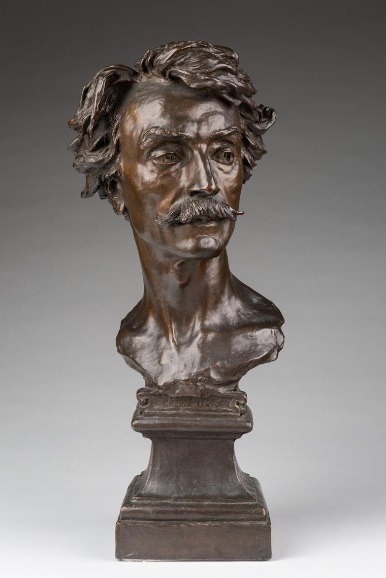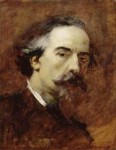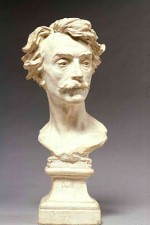
Jean-Baptiste Carpeaux
French, 1827-1875
Bust of Jean Léon Gérôme, 1871
bronze
SBMA, Gift of Dr. and Mrs. Robert J. Emmons
1997.47

Carpeaux, Self-Portrait, Oil on canvas, n.d.
"M. Carpeaux, let me say very quickly, has something else than gaiety — he has a feeling for the portrait, and he is exhibiting an excellent bust of M. Gérôme . . . where the character of the modeling is ingeniously studied, is surprisingly lifelike; it moves, it breathes, and freedom in execution here has a wonderful aspect." — Paul Mantz, 1872
RESEARCH PAPER
Jean Baptiste Carpeaux was the leading French sculptor during the period called the Second Empire in France (1851-1870). He was considered the favorite sculpture of Emperor Napoleon III. Carpeux produced many important works for private collectors as well as numerous prestigious state commissions.
This piece of art is bronze bust of the French artist Jean-Leon Gérôme, sculpted in 1871. This piece was completed four years before Carpeaux’s death in 1875 at the height of his skill and popularity. Carpeaux’s expressive style defied many of the academic classical conventions of the time. His work was considered a forerunner of the next generation of sculptors including August Rodin.
Carpeaux produced many busts of aristocratic clients and friends. This included his close friend Jean-Leon Gérôme. The bust of Gérôme was modeled in London, where Carpeaux, Gérôme, and other French artists had fled to avoid the political strife created by the Paris Commune at the end of the Franco-Prussian War.
In the work, we see Gérôme’s handsome, intense face animated by the delicate modeling of the surface to capture a lifelike intensity of his personality. One can only imagine the conversation and exchange and opinions between the two leading and opinionated French artists during the production of the piece. The realistic texture of skin and muscle tone make this piece realistic and believable. Gérôme’s wavy hair and mustache add important clues to his strong and engaging personality.
Gérôme was a prominent art teacher, painter, sculptor and academic artists of the late 19th Century. He taught at the École des Beaux-Arts and specialized in painting scenes of daily life in ancient Greece and Rome, rendered with minute realism and archaeological precision.
At age 54, due to failing eyesight, Gérôme transitioned to sculpture. He applied life-like tints to his marbles and liked to combine a variety of materials as the ancients had done. He was able to produce unexpectedly original results. He also combined various techniques with his skill in depicting realism to illustrate daily life from the ancient world.
Later in life, Gérôme lost public favor due to his outspoken position against the avant-garde of Manet and the Impressionists. Despite being one of the most famous and sought after artists of his time, Gérôme remains relatively unknown and continued to be judged by the conflicts in his later years. When he died in 1904 he had become so dissociated from the art community, there was no memorial to him.
Jean Baptiste Carpeaux was the son of a mason from Valenciennes, France. At age 17, he was accepted into École des Beaux-Arts in Paris. While at the École des Beaux-Arts, he studied in the studios of two of the most accomplished sculptors of mid-nineteenth-century France, François Rude and Francisque Joseph Duret. In 1854, Carpeaux won the Prix de Rome and was sent to study at the Villa Medici for five years. In Rome, he had firmly established his reputation as one of the leading artists and sculptors through a number of accomplished and challenging works, including Ugolino and His Sons.
During Carpeaux’s time, the artistic shift from Neo-Classicism to Romanticism was giving way to Realism. Realism required precise imitation of visual perceptions and was limited to facts of the world as the artist would personally experience them. His work was an important transition from Romanticism to Realism.
Throughout the 1860’s to 1870’s, Carpeaux enjoyed enormous success securing major commissions for public monuments such as the “Fountain of the Observatory in the Luxembourg Gardens” (1867-74), and architectural decorations such as “The Dance” (1866-69) for the new Garnier opera house in Paris.
As a business man, Carpeaux successfully commercialized his art for the public. He reproduced many of his famous public commissions and statutes in bronze, marble and terra cotta which were sold to private collectors.
Prepared for the Santa Barbara Museum of Art Docent Council by Marc Brody, January, 2014.
Bibliography
Hood Museum of Art, Dartmouth College, “Jean Baptiste Carpeaux”, http://hoodmuseum.dartmouth.edu/collections/overview/europe/sculpture/S99511.html
J. B. Speed Art Museum, Louisville, Ky., "Nineteenth Century French Sculpture," November 3-December 5, 1971.
Los Angeles County Museum of Art, "The Romantics to Rodin," March 4-May 25, 1980.
Metropolitan Museum of Art: “Heilbrunn Timeline of Art History,Jean Baptiste Carpeaux”, http://www.metmuseum.org/toah/works-of-art/1970.171.
Sterling and Francine Clark Art Institute, "A Romance With Realism," Williamstown, Mass., May 6-August 27, 1989.
Strickland, Carol, “The Annotated Mona Lisa”, Andrews McMeel, 2007.
Wagner, E. Middleton, "Sculpture of the Second Empire," Yale University Press, 1986.

COMMENTS
The son of a mason from Valenciennes, Jean-Baptiste Carpeaux studied at the École des Beaux-Arts in Paris in the studios of two of the most accomplished sculptors of mid-nineteenth-century France, François Rude (1784-1855) and Francisque Joseph Duret (1804-1865). Carpeaux succeeded in winning the Prix de Rome in 1854. By the end of the decade he had firmly established his reputation through a number of accomplished and challenging works, including the superbly modeled Ugolino and His Sons (1857-61).
Carpeaux enjoyed enormous popular success during the remaining years of the Second Empire, securing major commissions for public monuments such as the Fountain of the Observatory in the Luxembourg Gardens (1867-74) and architectural decorations, including most notably an important sculptural group entitled The Dance (1866-69) for the new opera house in Paris, designed by friend and celebrated architect Charles Garnier (1825-1898).
Perhaps the most gifted portraitist of his generation, Carpeaux produced many superb busts of both aristocratic clients and friends, including musicians and artists such as Charles Gounod (1818- 1893) and the acclaimed painter Jean-Leon Gérôme (1824-1904). The latter bust was modeled in 1871 in London, where Carpeaux, Gérôme, and many other French artists had fled to avoid the political strife created by the establishment of the short-lived Commune in Paris at the end of the Franco-Prussian War. His portrait revealed Carpeaux’s remarkable talent for capturing both the likeness and the spirit of his sitter, whose handsome face is animated by the delicate modeling of the surface. Numerous examples of this work were produced in bronze, marble, terra cotta, and, as here, plaster.
- Hood Museum of Art, Dartmouth College
SBMA CURATORIAL LABELS
This portrait bust comes out of the friendship between two Parisian artworld luminaries in the 1870s: Carpeaux, a sculptor, who had public commissions dotting the city, including the façade of the Paris Opéra and a fountain in the Luxembourg Gardens; and Gérôme, a painter famous for his detailed scenes from ancient Roman history. The wild hair, torqued shoulders, and worked surface teems with life. One senses the energetic hands of the sculptor smoothing the skin’s surface, finessing the flair of the mustache or an unruly lock of hair.
- Fire Metal Monument: Bronze, 2021
